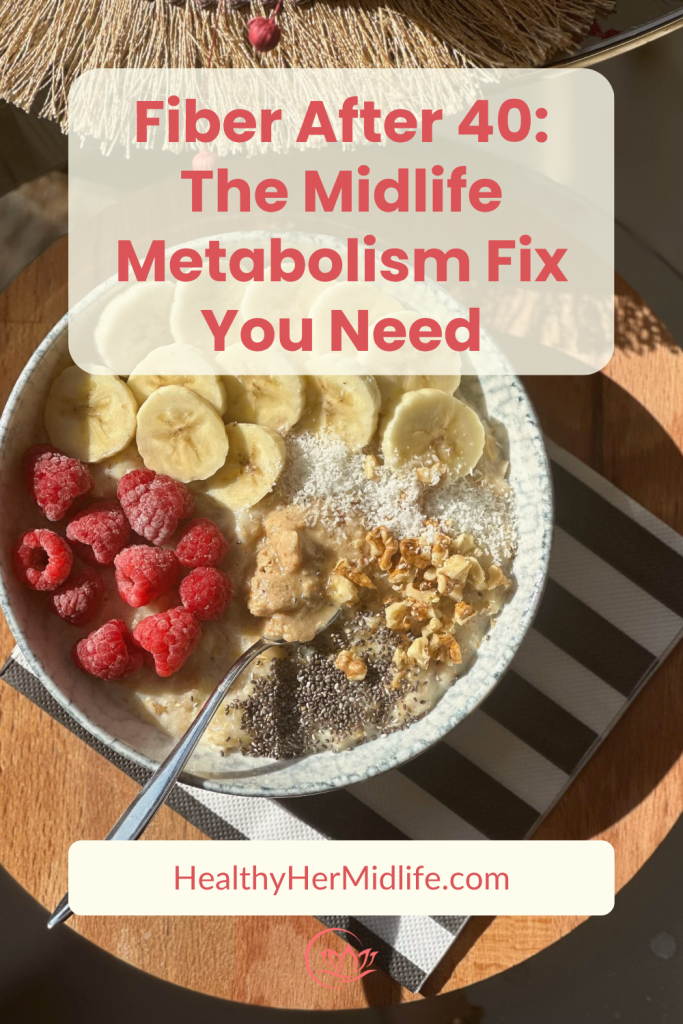Fiber: The Midlife Metabolism Fix You’ve Probably Overlooked
Are you dealing with stubborn belly fat, energy crashes, or blood sugar swings in midlife? You’re not alone. Once estrogen drops, our metabolism shifts — and suddenly, what used to work doesn’t anymore. But here’s the surprise: the fix may not be another diet or cutting calories. According to new research, one of the most powerful tools for midlife health is something most of us overlook — fiber.
A recent study of more than 200 postmenopausal African American women found a strong connection between fiber and midlife metabolism. Women who ate more fiber were up to 4 times less likely to have metabolic syndrome. That’s the cluster of belly fat, high blood sugar, high blood pressure, and high triglycerides that raises risk for heart disease and diabetes. And it didn’t matter if the fiber was soluble (beans, oats, chia) or insoluble (whole grains, veggies) — both types were protective.
Why Fiber Matters After 40
Here’s the thing: once estrogen drops in midlife, our bodies naturally shift toward storing more fat around the belly. At the same time, blood sugar and cholesterol can creep up, and inflammation runs higher. All of that sets the stage for metabolic syndrome. But fiber fights back on multiple levels:
- Balances blood sugar: Soluble fiber (like in beans, oats, and chia seeds) slows down how quickly sugar enters your bloodstream. That means fewer spikes, steadier energy, and fewer cravings.
- Supports your gut microbiome: Fiber feeds your healthy gut bacteria. When they thrive, they release anti-inflammatory compounds that protect your metabolism.
- Lowers triglycerides and cholesterol: Both soluble and insoluble fiber help reduce the amount of fat circulating in your blood.
- Helps with weight management: High-fiber foods fill you up without extra calories, which can help curb belly fat gain without restrictive dieting.
Soluble vs Insoluble Fiber: What’s the Difference?
Soluble fiber dissolves in water and forms a gel in your gut. Think of it as a sponge that slows digestion and steadies blood sugar.
- Examples: oats, beans, lentils, apples, chia seeds, flaxseed
- Benefits: balances blood sugar, lowers cholesterol, keeps you fuller longer
Insoluble fiber doesn’t dissolve in water. Instead, it adds bulk and helps food move more efficiently through your digestive tract.
- Examples: whole wheat, brown rice, leafy greens, broccoli, carrots, nuts
- Benefits: supports gut regularity, prevents constipation, keeps digestion moving
Most fiber-rich foods contain a mix of both — so variety matters more than perfection.
How Much Fiber Do You Really Need?
Most women over 40 get less than 15 grams a day — but the recommended amount is closer to 25–30 grams. That may sound like a lot, but it’s actually just a few simple shifts:
- 1 cup of lentils = 15 grams
- 2 tablespoons of flaxseed = 4 grams
- 1 apple with skin = 4 grams
- 1 cup of broccoli = 5 grams
Add a couple of these to your day, and you’re already there.
Simple Daily Fiber Upgrades
- Swap white rice for quinoa or barley.
- Add beans or lentils to your soups and salads.
- Sprinkle chia or flax on yogurt or oatmeal.
- Snack on veggies and hummus instead of chips.

The Takeaway
Fiber isn’t just for digestion. It’s a midlife powerhouse that can help protect against belly fat, calm inflammation, and keep your metabolism working for you — not against you. And the best part? You don’t need supplements or complicated plans. Just more plants on your plate.
Want more simple, science-backed shifts for energy and weight after 40? Download my free Midlife Metabolism Reset Guide — your 3-day plan to beat bloat, boost energy, and start feeling like yourself again.
Still Hot Flashing, Exhausted, Gaining Weight or Frustrated With Midlife Changes?
In my 90-Day Midlife Reset, I help midlife women reduce bloating, sleep better, and feel like themselves again—without food rules, overwhelm, or shame.








